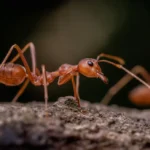Ants are fascinating creatures that have been around for millions of years, surviving in diverse environments all over the world. As one of the most industrious insects, ants play essential roles in ecosystems, from aerating the soil to recycling nutrients. But how long do these tiny workers live? The lifespan of an ant varies significantly depending on factors like species, environmental conditions, and the ant’s role within the colony.
The Average Lifespan of an Ant
On average, most worker ants live anywhere from a few months to a year. However, this can vary greatly between species and roles. For instance, ants in colder climates may have shorter lifespans, while those in tropical areas can live longer due to more stable environmental conditions.
Lifespan by Ant Type
- Worker Ants: Worker ants, which are the non-reproductive females tasked with foraging, defending the nest, and caring for the queen’s brood, typically live for several months. In some species, like the red imported fire ant, worker ants might survive up to 6 months, while in others, like the Argentine ant, they can live for up to a year.
- Male Ants: Male ants have one primary purpose: mating with the queen. Because of this singular role, their lifespans are very short. Male ants typically live for only a few weeks. After mating, they die, as they do not contribute to the survival or maintenance of the colony.
- Queen Ants: Queen ants, the reproductive females of the colony, have the longest lifespan of any ants. A queen can live anywhere from several years to, in some exceptional cases, up to 30 years. The queen’s role is critical, as she is the only ant in the colony capable of laying eggs. The lifespan of a queen is largely influenced by her species and the resources available to her in the colony. Some species of ants, such as the black garden ant (Lasius niger), have queens that can live for over 15 years in the right conditions.
Factors That Affect Ant Lifespan
Several factors can influence the lifespan of an ant, including:
- Species: Different species of ants have different life expectancies. For example, while a common field ant might live for just a few months, a carpenter ant queen could live up to 7 years. The genetic makeup of each species affects its biology and longevity.
- Role in the Colony: As mentioned earlier, the role of the ant within the colony plays a significant role in its lifespan. Worker ants, who are constantly foraging and interacting with potential threats, often face higher risks and thus have shorter lifespans compared to the protected queen, who is focused solely on reproduction.
- Environmental Conditions: The environment in which ants live has a profound impact on their longevity. Ants living in warmer climates tend to have longer lifespans than those in colder areas, as the latter may face harsher conditions that shorten their lives. Availability of food and shelter, as well as threats from predators, also factor into an ant’s overall lifespan.
- Predators and Threats: Ants face various predators such as birds, mammals, lizards, and other insects. Ant colonies are also vulnerable to environmental disturbances, like floods, fires, or human activity, which can significantly reduce the life expectancy of ants. Ants living in more secure or isolated environments tend to live longer.
- Colony Health: The overall health and stability of the colony can impact individual ants’ lifespans. If the colony is disrupted by factors like disease, predation, or environmental changes, individual ants may have reduced lifespans.

Conclusion
In conclusion, the lifespan of an ant varies depending on its species, role in the colony, and environmental conditions. Worker ants typically live for several months, male ants have very short lives, and queen ants can live for many years, with some surviving up to 30 years. Understanding the factors that contribute to an ant’s lifespan provides valuable insight into the biology and ecology of these incredible insects. Whether you’re watching ants in your backyard or studying them under a microscope, the lives of ants are as diverse and dynamic as the colonies they form.



